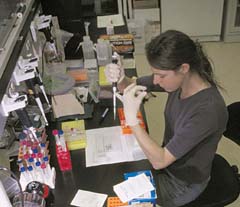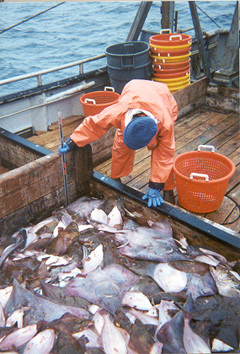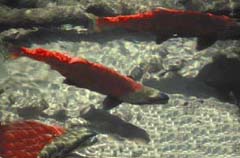| NOAA Magazine || NOAA Home Page |
 October
16, 2002 — The
Northeast Pacific Ocean holds a wealth of diverse habitats and natural
resources, but we still know very little about them. Fortunately, NOAA’s
Northwest Fisheries Science Center studies living marine resources
and their habitats in the Northeast Pacific Ocean—primarily off
the coasts of Washington and Oregon and in freshwater rivers and streams
in Washington, Oregon, Idaho and Montana (i.e., where anadromous
fish—like salmon go). This represents approximately 150,000 square
miles of ocean and freshwater habitat—or about 75 million football
fields.
October
16, 2002 — The
Northeast Pacific Ocean holds a wealth of diverse habitats and natural
resources, but we still know very little about them. Fortunately, NOAA’s
Northwest Fisheries Science Center studies living marine resources
and their habitats in the Northeast Pacific Ocean—primarily off
the coasts of Washington and Oregon and in freshwater rivers and streams
in Washington, Oregon, Idaho and Montana (i.e., where anadromous
fish—like salmon go). This represents approximately 150,000 square
miles of ocean and freshwater habitat—or about 75 million football
fields.
The NWFSC's headquarters at Montlake (Seattle, Wash.) was created
in 1930 and was the first government laboratory dedicated to the study
of living marine resources on the West Coast. Today, it is one of five
NOAA Fisheries science
centers and is responsible for providing scientific and technical
support for the management and conservation of the Pacific Northwest region's
anadromous and marine fishery resources. The Center’s mission is
to understand and improve the condition of living marine resources and
their habitats for the benefit of this and future generations. As a result,
the Center’s research brings together a number of disciplines (including
fisheries science, marine biology and ecology, genetics, biochemistry,
molecular biology, oceanography and physiology) and in many cases is conducted
in cooperation with other organizations (including federal, state, local,
and tribal agencies and universities throughout the region, nation and
world).
 It
is hard to protect, conserve and wisely use resources that we don’t
understand. NWFSC scientists study key living marine resources in the
Pacific Northwest to understand their biology and ecology. Center scientists
also study man-made and natural hazards that can impact these resources
(e.g., harmful algal blooms, fishing operations, point and non-point source
pollutants, climate change and other environmental factors). They do this
by using a variety of tools and techniques (e.g., state-of-the-art molecular
techniques, stock assessment models, multibeam sonars, echosounders and
sometimes even remotely operated vehicles) to learn about fish on many
different levels (from their DNA on up) and the habitats they use. The
NWFSC conducts the science that managers need to make sound decisions
about the Pacific Northwest’s valuable marine resources (e.g., how
many fish can be safely harvested in a particular fishery or whether a
species needs protection under the Endangered Species Act). Center scientists
accomplish this by translating what they learn to NOAA’s
Northwest Regional Office, the Pacific Fishery Management Council,
the Puget Sound Shared Strategy for Salmon Recovery and other key stakeholder
groups. The NWFSC also develops and applies new technologies, techniques
and tools to support the conservation, recovery and wise use of the Pacific
Northwest’s living marine resources. These innovations can lead
to new or better ways to conduct research and understand living marine
resources and their habitats.
It
is hard to protect, conserve and wisely use resources that we don’t
understand. NWFSC scientists study key living marine resources in the
Pacific Northwest to understand their biology and ecology. Center scientists
also study man-made and natural hazards that can impact these resources
(e.g., harmful algal blooms, fishing operations, point and non-point source
pollutants, climate change and other environmental factors). They do this
by using a variety of tools and techniques (e.g., state-of-the-art molecular
techniques, stock assessment models, multibeam sonars, echosounders and
sometimes even remotely operated vehicles) to learn about fish on many
different levels (from their DNA on up) and the habitats they use. The
NWFSC conducts the science that managers need to make sound decisions
about the Pacific Northwest’s valuable marine resources (e.g., how
many fish can be safely harvested in a particular fishery or whether a
species needs protection under the Endangered Species Act). Center scientists
accomplish this by translating what they learn to NOAA’s
Northwest Regional Office, the Pacific Fishery Management Council,
the Puget Sound Shared Strategy for Salmon Recovery and other key stakeholder
groups. The NWFSC also develops and applies new technologies, techniques
and tools to support the conservation, recovery and wise use of the Pacific
Northwest’s living marine resources. These innovations can lead
to new or better ways to conduct research and understand living marine
resources and their habitats.
NWFSC
Primary Research Areas
The
NWFSC is organized into five
research divisions that together conduct research in four primary
areas:
- Status of Stocks: Maintaining healthy fish stocks is important to commercial, recreational and subsistence fisheries. Stock assessments monitor the state or health of a fish stock (like the U.S. Census monitors the characteristics of the U.S population—birth and death rates, age and sex statistics, etc.). Center scientists conduct and coordinate stock assessments for marine groundfish on the West Coast and salmon stocks in the Pacific Northwest by taking a variety of measurements. For marine fish, these measurements typically include data from fishing vessel catch or landings, scientific surveys, observers stationed on fishing vessels, and life history studies. Once the information is collected, Center scientists analyze the data, and use mathematical models to draw conclusions from the results. Stock assessments provide the basis for identifying overfished and threatened stocks, guiding and monitoring rebuilding of overfished stocks, and forecasting biologically sustainable harvest levels for healthy stocks.
- Impacts
of Manmade Stress/Risks: Humans affect the environment around
them and as a result living marine resources in the Pacific Northwest
face a number of risks, from toxic chemicals in sediments to hydropower
systems to physically degraded habitats. Each different life stage (e.g.,
egg, juvenile or adult) and species is affected differently. Center
scientists are conducting research to better understand how salmon,
marine fish and marine mammals react to these stresses and to quantify,
assess and minimize the risks that they encounter during their lives.
The Center’s research provides the underpinning for national,
state and tribal management decisions—including how to minimize
the impacts of hydropower systems on salmon, what habitats to restore,
and when to close and open a fishery after an oil spill.

- Ecosystem
Characteristics: Living marine resources in the Pacific Northwest
use a variety of ecosystems from freshwater streams and rivers to estuaries
and the ocean. Our knowledge of these systems, as they apply to marine
fish, salmon and marine mammals, is currently very limited. Center scientists
are conducting research on physical and biological processes that influence
aquatic, marine and esutarine ecosystems in the Pacific Northwest (including
sediment delivery, upwelling and tidal processes and nutrient inputs
and cycles), as well as the affects of invasive species, toxic phytoplankton,
climate change and natural environmental fluctuations.

- Recover and Rebuild Species: Pacific Northwest fisheries are important for biological, economic, cultural, aesthetic and recreational reasons. Over the past several decades, certain fish stocks have become depleted and in some cases are in danger of extinction. Each living thing has a unique set of genetic material. The Center studies genetic variation to learn about salmon populations and conducts research on the population structure of marine fish and killer whales. The Center also develops innovative recovery tools like captive breeding (or broodstock) programs to propagate salmon species, new techniques for rearing hatchery fish, and culture techniques to rear marine fish in captivity. In addition, Center scientists are directly involved in salmon recovery planning efforts on the West Coast; they chair Technical Recovery Teams that are assessing factors responsible for salmon decline and developing criteria for delisting endangered and threatened salmon populations.
NWFSC’s
Research Endeavors
The
Center’s research is conducted at its headquarters at Montlake (Seattle,
Wash.), as well as at its five research stations in Washington and Oregon.
To follow are descriptions of just a few of the NWFSC successful research
endeavors:
- Astoria Canyon Research: Center scientists conduct surveys to learn about fish and the habitats they use. In the summer of 2001, the NWFSC and NOAA’s PMEL led a team of scientists on an expedition to study Astoria Canyon — an unexplored submarine canyon that extends westward from where the Columbia River meets the Pacific Ocean. Scientists mapped, explored, and documented the physical, chemical and biological systems of the canyon. Information collected from this exploration will help scientists answer important questions about where marine fish and invertebrates live, differences between heavily fished and more “pristine” areas, and the structure of the canyon and how it influences life in the ocean.
- Assessment of All West Coast Salmon and Steelhead Runs: Over the past several decades, wild salmon and steelhead populations have declined dramatically due to a number of factors, including overharvest, hydropower systems, habitat destruction and over-reliance on hatcheries, as well as climate change and other environmental factors. In the 1990s, the NWFSC launched a sweeping review of all West Coast salmon and steelhead runs to determine their productivity and abundance. Center scientists shared the results of their work with regional managers, who then decided to protect 26 groups of salmon and steelhead populations in Washington, Oregon, Idaho and California under the Endangered Species Act. Center scientists are now conducting research to support the recovery of these protected populations.
- Innovative Approaches: Salmon and groundfish are challenging to study because they live in a world of water and move around (for example, salmon migrate long distances, which can total thousands of miles during their lives). To address this challenge, the NWFSC developed technologies to monitor salmon movement. Specifically, the passive integrated transponder tag (i.e., a small device containing a computer chip that is inserted into the body cavity of juvenile salmon). Electronic systems set up at dams detect these tags and send information about the salmon to a centralized database. PIT tags have changed the way salmon (as well as other species, such as sea turtles) are studied and have greatly improved our understanding of salmon migration and survival. Similarly, Center scientists are successfully using acoustic (sonar-based) technologies with high-frequency sound pulses to measure groundfish abundance and map their distribution. These technologies are improving our understanding of groundfish stocks and are enabling us to study groundfish in many more areas of the ocean.
- Scientists Locate A Source of Toxic Algae Off Cape Flattery: A team of scientists from the NWFSC and the University of Washington are gaining a better understanding of toxic algae that threatens the livelihood of coastal communities along Washington state's coast. In a study published in the September (2002) issue of Limnology and Oceanography, scientists provided evidence showing that an origin of Pseudo-nitzschia (algae that produce the neurotoxin domoic acid) may be located off the tip of Cape Flattery in the Juan de Fuca eddy. Harmful algal blooms have been responsible for beach closures and the loss of millions of dollars in revenue to coastal communities. This study and subsequent studies by Center scientists and their collaborators will give managers vital information to help predict harmful algal blooms before they hit the coast.
Other NWFSC news articles and news releases can be found on the NWFSC Web site.
The Northwest Fisheries Science Center celebrated the 70th anniversary of its Montlake facility on May 23rd and 24th, 2002. Over the years, Center researchers have become widely recognized for their expertise and accomplishments in the following areas:
- Understanding and mitigating the impacts of hydroelectric dams.
- Conducting ecological and genetic research on salmon in support of the Endangered Species Act.
- Evaluating effects of marine pollutants on coastal ecosystems throughout the United States.
- Enhancing the quality, safety and value of fishery products.
- Developing methodologies for marine aquaculture and salmon enhancement.
- Emerging fields of marine biotechnology.
- Assessing trends in fish abundance and potential fishery yield.
In the future, the NWFSC will continue to provide the scientific basis to meet NOAA's stewardship responsibility to conserve and manage living marine resources and their habitats with an emphasis on Pacific Northwest ecosystems.
Key
Northeast Pacific Living Marine Resources Studied by the NWFSC
|
Relevant
Web Sites
NOAA Fisheries
NOAA's Northwest Fisheries Science Center
NOAA’s Northwest Regional Office
NOAA's NWFSC: Conservation Biology Division
NOAA's NWFSC: Environmental Conservation Division
NOAA's NWFSC: Fishery Resource Analysis and Monitoring Division
NOAA's NWFSC: Fish Ecology Division
NOAA's NWFSC: Resource Enhancement and Utilization Technologies Division
NOAA's National Marine Fisheries Service
NOAA's Marine fish enhancement and aquaculture research
NOAA OCEAN SCIENTISTS EXPLORE DEPTHS OF OREGON'S ASTORIA CANYON: Bold Research
Approach Reaps New Discoveries—Maps, Species
HAPPY BIRTHDAY NWFSC: CELEBRATING 70 YEARS OF FISHING SCIENCE
Media
Contact:
Gordon
Helm,
NOAA Fisheries, (301) 713-2370.